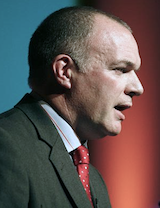 We have reached a seminal moment in the comms channel's history and it's time to take your business, and SME organisations, to the next level. That's the upshot of this year's Margin in Voice and Data event that urged delegates to help UK SMEs build their future on an optimised networked foundation.
We have reached a seminal moment in the comms channel's history and it's time to take your business, and SME organisations, to the next level. That's the upshot of this year's Margin in Voice and Data event that urged delegates to help UK SMEs build their future on an optimised networked foundation.
The SME connectivity opportunity is a gift to comms resellers able to give the market what it wants. And the demographics of this vibrant sector also run in the channel's favour. To understand the market you need to think of the network as the foundation where nothing pre-digital exists. And a high degree of success awaits astute resellers. Not surprisingly, the SME opportunity featured prominently at this year's Margin in Voice and Data event (9th June, Forest of Arden Hotel and Country Club), which urged the channel to help UK SMEs leverage their network to the max.
The size of the opportunity is gargantuan. Paul Cunningham, Content Director, told delegates that SMEs represent 99.9 per cent of the UK's 5.2 million businesses, and they contribute over £1.6 trillion (47 per cent) of private sector turnover to the national economy. Nor is that all: Seven per cent of UK businesses are high growth small enterprises and account for 60 per cent of new jobs being created. Not surprisingly, SMEs are now considered to be the engines of growth, and communications is critical to these organisations with even the smallest micro-business spending an average £1,000 per annum on comms. Small businesses spend circa £4,000 and medium sized companies invest around £11,500 a year, which all tolled represents a sizeable market opportunity.
Another upside, the SME network experience is improving. In 2014, 56 per cent of SME premises were connected to 30Mbps-plus, rising to 82 per cent in 2017 (Ofcom figures). But 42 per cent of SMEs report Internet connectivity problems and 29 per cent complain of service availability, which, in a growth market, is not ideal. But it's a daily scenario that must be managed.
Glitches aside, the network is the foundation of a growth orientated business model, underlined by SMEs that are categorised as high users of online services. "They grow much faster so there is a clear need for an enhanced network experience," said Cunningham. "You've got to build value to make the network effective for SMEs."
Amid these converging factors there is much opportunity to grip. More intriguing is that 83 per cent of SMEs in the UK consider communication services to be fundamental to their business (2015 figures cited by Ofcom), so there is a requirement for enhanced network experiences based on availability, service reliability, service guarantees, SLAs, monitoring and reporting.
Cloud applications also have significant value but despite the current focus of many providers only 23 per cent of SMEs report using cloud services (Ofcom 2015). "There is potential for considerable market growth with greater SME awareness and adoption," commented Cunningham. "But a recent study by BCSG found that just under half of SMEs in the UK are willing to purchase cloud services from their telecoms supplier, while 40 per cent said they were willing to buy software and other tools from operators to help grow their business."
Here's the question delegates loved - how to effectively address this shifting market? "Verticalisation into SME markets is an important way of approaching this sector," added Cunningham. "Bundling ICT products and services with price plans and offers that meet the needs of a particular industry can be effective. There is a niche opportunity for smaller channel players that are able to add specialist market knowledge."
Harnessing data is also an important aspect of building a long-term business model and understanding the opportunities at hand. There are various ways to harness data, but these methods are mostly viewed as challenging and complex. That said, smaller businesses can exploit day-to-day data that's being drawn from billing and CRM systems, for example, offering valuable insights into their own business and their customers' operations.
As a shining example Cunningham cited Union Street's Benchmarking service which is based on opted-in data from its customers. The subsequent reports compare and contrast their performance against peers. "This is an example of how business analytics can be simplified and integrated to serve the needs of customers," stated Cunningham.
But the overall picture can be complicated and a way to break down complexity into simple building blocks must be found. Enter the 'business platform', a foundation slab that underpins the building stones of a future business model. "When breaking aspects of the market down into their component parts not all of them will be relevant to a business, but there will be some elements of each of those business blocks to think about," noted Cunningham. "For instance, adapting to the cloud, and it's crucial to be analytical and think about data, as well as energising sales teams, motivating markets and building value into your business."
The strategic outcome of this year's Margin in Voice and Data event ought to be a grand initiative to elevate the network as the foundation of SME businesses. The immediate job is not to reflect on market possibilities but to get down to work, with the onus on cloud applications, analytics, marketing and sales growth, all building blocks addressed by this year's main sponsors, including keynotes from NFON UK Managing Director Rami Houbby; Mark Curtis-Wood, Nimans' Head of Network Services; and Adam Zoldan, Director, Knight CF. Other speakers included Andy Grant, Managing Director of Bowan Arrow; and John Donohoe, Partner at sales development firm Believe.•
